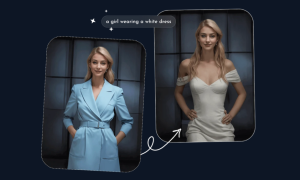
The fashion industry is undergoing a technological renaissance, with artificial intelligence (AI) playing a pivotal role.
Among the myriad innovations, AI clothes swap tools stand out as a revolutionary force reshaping how we experience fashion. These tools not only enhance consumer engagement but also drive sustainability and efficiency in the fashion ecosystem.
This article delves into the transformative impact of AI clothes swap tools, exploring their benefits, challenges, and future prospects. So, without any further ado, let’s begin.
The Revolutionary Impact of AI Clothes Swap Tools on the Fashion Industry
First let’s explore the advent of the fashion sector with the advent of AI clothes changing technologies.
Enhanced Consumer Experience
One of the most significant advantages of AI clothes swap tools is the enhanced consumer experience. These tools provide personalized outfit recommendations, allowing customers to see how different clothing items look on them before making a purchase.
Virtual try-ons eliminate the guesswork and increase fitting accuracy, leading to higher customer satisfaction and reduced return rates.
Sustainability and Waste Reduction
AI clothes swap tools also promote sustainability in fashion. By enabling digital wardrobe management, these tools encourage consumers to make more conscious choices. They can visualize combinations of existing and new pieces, reducing the need for excessive purchasing.
Additionally, the rise of virtual try-ons supports the second-hand clothing market, as customers can see how pre-owned items will look on them, fostering sustainable fashion practices.
Design and Production Efficiency
For designers and manufacturers, AI clothes swap tools streamline the design process. AI-assisted tools can quickly generate realistic visualizations of new designs, speeding up prototyping and reducing material waste. Precise measurements and predictions offered by these tools ensure that production is more efficient, with fewer resources spent on trial and error.
Key Players and Innovations in the Market
Several companies and startups are leading the charge in AI clothes swap technology. Notable players include Fotor, a versatile photo editing platform that has integrated AI-powered tools to enable realistic virtual clothing swaps.
Another key player is Faceswapper.ai, which specializes in using advanced AI algorithms for seamless and accurate AI clothes changer applications. These companies leverage sophisticated algorithms and extensive datasets to provide realistic and reliable virtual clothing swaps, pushing the boundaries of what’s possible in digital fashion technology.
Challenges and Considerations
However, like every technology, despite their benefits, AI clothes swap tools face several challenges.
Technical and Ethical Challenges
Data privacy and security are paramount, as these tools require access to personal images and measurements. Ensuring that this data is protected is critical to maintaining consumer trust.
Additionally, algorithmic bias can pose issues, as AI models must be trained on diverse datasets to avoid excluding certain body types or ethnicities. Ensuring accuracy and realism in AI-generated swaps is another technical hurdle, as even minor inaccuracies can detract from the user experience.
Market Adoption Barriers
Adopting AI clothes swap tools can be challenging for some retailers. Consumer skepticism and resistance to change are common barriers, as customers may be hesitant to trust AI-driven recommendations. Integration with existing retail systems can also be complex and costly, particularly for smaller businesses. These challenges necessitate careful planning and investment to ensure successful implementation.
What are the Future Prospects and Trends of AI Clothes Swap Tools?
The future of AI clothes swap tools looks promising, with emerging technologies poised to enhance their capabilities further.
Emerging Technologies and Innovations
Integrating augmented reality (AR) and virtual reality (VR) with AI clothes swap tools will provide even more immersive and interactive experiences.
- AR/VR can enable customers to virtually “try on” clothes in a 3D environment, offering a more engaging and realistic experience.
- Advancements in AI-driven fashion design will also allow designers to create more innovative and personalized clothing, pushing the boundaries of creativity.
Predicted Market Growth and Opportunities
The AI clothes swap market is expected to grow significantly in the coming years. According to market research, the global virtual fitting room market, driven by AI technologies, is projected to reach USD 10.5 billion by 2026.
This growth presents numerous opportunities for businesses to innovate and capitalize on AI’s potential. New business models, such as subscription-based virtual styling services and AI-driven fashion platforms, are likely to emerge, offering fresh revenue streams and enhancing customer engagement.
Conclusion
AI clothes swap tools are revolutionizing the fashion industry by enhancing consumer experiences, promoting sustainability, and improving design and production efficiency. While challenges remain, the future of these tools is bright, with emerging technologies and market growth presenting exciting opportunities.
As AI continues to evolve, its impact on fashion will only deepen, reshaping how we shop, design, and interact with clothing. Brands that embrace these innovations will be at the forefront of the industry’s transformation, gaining a competitive edge.
Ultimately, AI clothes swap tools have the potential to create a more personalized, inclusive, and environmentally friendly fashion landscape.

